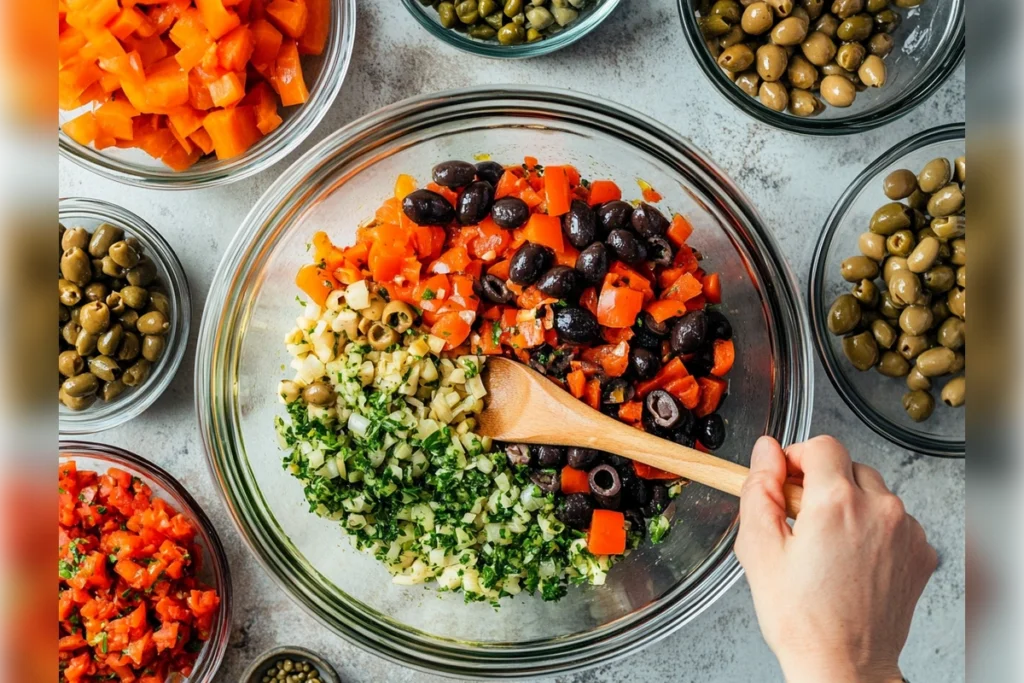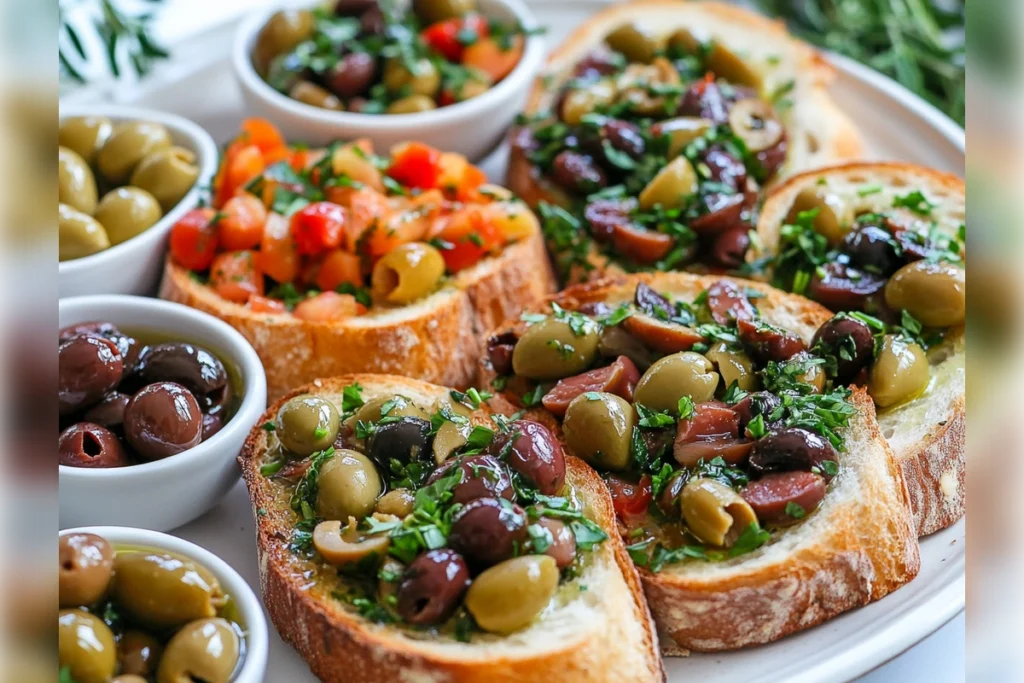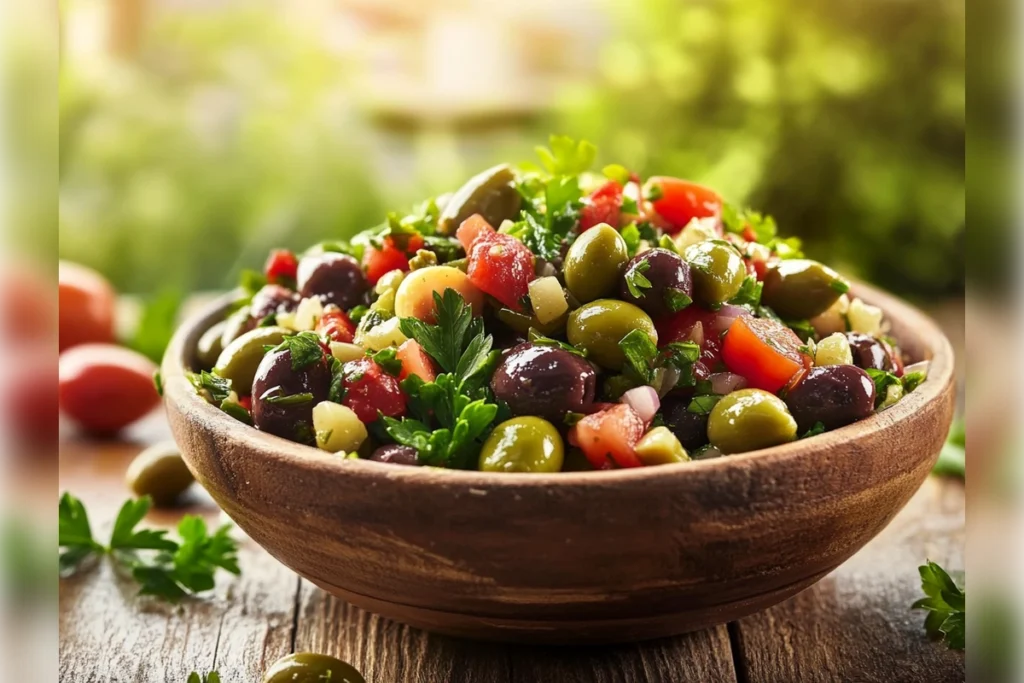Olive salad isn’t just a side dish it’s a vibrant, flavor-packed medley that can transform any meal. Whether served as a sandwich topping, a salad centerpiece, or a gourmet appetizer, this dish is a versatile addition to your culinary repertoire. Rooted in Mediterranean traditions and popularized in New Orleans cuisine, this salad has earned its spot in both casual meals and fine dining experiences.
In this article, we’ll dive deep into everything you need to know about making the perfect olive salad recipe. From its rich history and essential ingredients to detailed step-by-step instructions, creative variations, and health benefits we’ve got you covered. By the end, you’ll not only know how to whip up this delicious salad but also how to store, serve, and savor it to perfection.
Let’s begin with the fascinating background of olive salad and why it’s become a favorite in kitchens worldwide.
Introduction to Olive Salad
What is Olive Salad?
Olive salad is a tangy, briny, and savory dish traditionally made with a mix of green and black olives, pickled vegetables, herbs, and olive oil. While it can be enjoyed on its own, it’s often used as a topping for sandwiches most famously the Muffuletta sandwich from New Orleans. Its distinct texture and bold flavors make it a crowd-pleaser at parties, picnics, and family dinners.
The Origins of Olive Salad and Its Connection to New Orleans Cuisine
The olive salad recipe has roots in Mediterranean cuisine, where olives have been a staple for centuries. However, it gained widespread recognition in the United States through Italian immigrants who settled in New Orleans. They introduced the Muffuletta sandwich, a massive sandwich filled with deli meats and cheese, topped with an unforgettable olive salad mix. Today, this salad is synonymous with Louisiana’s food culture, adding a zesty punch to countless dishes.
Why Olive Salad is a Versatile Dish
What makes olive salad so special? Its versatility. You can enjoy it in so many ways:
- As a spread for sandwiches and wraps
- Mixed into pasta salads
- Served atop grilled meats or fish
- As a bruschetta topping
Plus, it’s an ideal recipe for meal prep since it can be made in advance and stored for several days without losing its flavor.
Whether you’re a seasoned chef or a kitchen newbie, mastering the olive salad recipe is a must. Next, we’ll look at the key ingredients you’ll need to get started.
Key Ingredients for Olive Salad
Essential Ingredients for a Classic Olive Salad Recipe
Creating the perfect olive salad recipe starts with high-quality ingredients. Each component adds a unique texture and flavor, blending into a tangy, savory, and slightly spicy salad. Below is a quick look at the must-have ingredients:
| Ingredient | Quantity | Purpose |
|---|---|---|
| Green Olives | 1 1/2 cups, halved | Provide briny flavor |
| Black Olives | 1 cup, halved | Add depth and richness |
| Giardiniera | 1 cup, chopped | Brings tanginess |
| Red Wine Vinegar | 1/4 cup | Enhances acidity |
| Olive Oil | 1/2 cup | Adds richness and smoothness |
| Capers | 1 tbsp | Infuses salty notes |
| Garlic Cloves | 6, minced | Adds aromatic punch |
| Red Pepper Flakes | 1 tsp | Provides subtle heat |
| Celery | 1/4 cup, chopped | Adds a crisp texture |
| Parsley | 1 tbsp, minced | Fresh herbal notes |
Substitutes and Variations for Common Ingredients
Flexibility is the beauty of an olive salad recipe. If you’re missing an ingredient, don’t stress you can easily swap it out:
- Green Olives: Use Castelvetrano or Manzanilla olives for their buttery flavor.
- Black Olives: Kalamata olives offer a robust, earthy profile.
- Giardiniera: Substitute with pickled cauliflower or artichoke hearts.
- Red Wine Vinegar: Apple cider vinegar or white wine vinegar works well too.
Experimenting with ingredients can lead to exciting flavor twists. If you’re a fan of spicy dishes, try adding chopped jalapeños. For a touch of sweetness, diced roasted red peppers are a great option.
The Role of Different Types of Olives in Olive Salad
The star of any olive salad recipe is, of course, the olives. Each variety contributes a distinct taste:
- Green Olives: Bright, slightly tangy, and firm.
- Black Olives: Mild, earthy, and soft.
- Kalamata Olives: Rich, meaty, and slightly fruity.
Balancing these flavors ensures that every bite is a symphony of taste.
Looking for a complementary dish? Check out this Beet Feta Salad Recipe for another vibrant salad option.
Step-by-Step Olive Salad Recipe

Preparation Time and Serving Size
Before diving into the recipe, let’s get an overview of the prep time:
- Preparation Time: 25 minutes
- Chill Time: 8 hours (for optimal flavor infusion)
- Serving Size: 16 servings (1/4 cup per serving)
Step-by-Step Instructions for Making Olive Salad
Follow these easy steps to create the ultimate olive salad recipe:
- Prepare the Dressing:
- In a large mixing bowl, whisk together olive oil, red wine vinegar, minced garlic, dried oregano, and red pepper flakes.
- Chop and Mix Vegetables:
- Dice the green olives, black olives, and giardiniera.
- Add chopped celery, capers, and roasted red peppers.
- Combine Everything:
- Add the chopped vegetables to the dressing and mix thoroughly.
- Add Fresh Herbs:
- Stir in fresh parsley for an extra burst of flavor.
- Marinate:
- Cover the bowl and refrigerate the salad for at least 8 hours, stirring occasionally to ensure the dressing coats everything evenly.
- Serve:
- Before serving, give the salad a final stir. Enjoy it chilled as a sandwich topping, salad side, or standalone dish.
Expert Tips for the Best Flavor
- Marination is Key: Allowing the salad to sit for at least 8 hours enhances the flavors significantly.
- Quality Ingredients: Use high-quality olive oil and fresh herbs for the best results.
- Adjust Acidity: Taste the dressing before mixing and adjust the vinegar if needed.
Serving Suggestions
The versatility of this olive salad recipe shines when paired with various dishes:
- Serve it atop toasted baguette slices.
- Add it to a Muffuletta sandwich.
- Mix it with pasta salad.
For a hearty meal pairing, try this delicious Cornbread Salad recipe.
Different Variations of Olive Salad
Muffuletta Olive Salad Recipe
The Muffuletta olive salad recipe is perhaps the most famous variation of this dish, originating from the vibrant city of New Orleans. This salad isn’t just a side dish it’s a crucial part of the iconic Muffuletta sandwich. Packed with green and black olives, pickled vegetables, garlic, and zesty herbs, it’s a bold explosion of flavor.
Key Ingredients for Muffuletta Olive Salad:
- Green Olives
- Black Olives
- Giardiniera
- Red Wine Vinegar
- Olive Oil
- Garlic
- Capers
This variation often includes finely diced salami or ham for added richness. Serve it generously atop crusty Italian bread, and you’ve got yourself a classic Muffuletta experience.
Looking for another sandwich-inspired recipe? You might enjoy this Chicken Parm Sandwich Guide.
Mediterranean-Inspired Olive Salad Variations
Mediterranean cuisine is known for its fresh, vibrant flavors, and the olive salad recipe fits right in. By adding ingredients like feta cheese, sun-dried tomatoes, and fresh basil, you can give your olive salad a Mediterranean twist.
Key Additions for a Mediterranean Olive Salad:
- Crumbled Feta Cheese
- Sun-Dried Tomatoes
- Fresh Basil
- Lemon Zest
This variation works beautifully as a side dish for grilled fish or a topping for pita bread.
Vegan and Gluten-Free Olive Salad Options
For a vegan-friendly olive salad recipe, simply ensure all your ingredients are free from animal by-products. Thankfully, most olive salads are naturally vegan, but be mindful of pre-packaged giardiniera mixes they might include non-vegan ingredients.
Vegan Olive Salad Tips:
- Use vegan-certified giardiniera.
- Add chickpeas for extra protein.
- Include roasted artichokes for richness.
For gluten-free options, avoid serving the salad with bread unless it’s specifically labeled gluten-free. Pair it with gluten-free crackers, or serve it atop a bed of leafy greens for a salad-style twist.
Craving more Mediterranean delights? You might enjoy this Marinated Artichoke Recipe.
How to Serve Olive Salad

Olive Salad as a Sandwich Topping
One of the most popular ways to enjoy an olive salad recipe is as a sandwich topping. Whether you’re making a Muffuletta sandwich or a simple turkey sub, olive salad adds a tangy, savory kick that elevates every bite.
Pro Tip: Use a generous layer of olive salad to ensure every bite is packed with flavor.
Serving Olive Salad with Bread and Crackers
Olive salad shines when served as part of an appetizer platter. Pair it with crusty bread, crackers, or toasted baguette slices for an irresistible appetizer.
Serving Ideas:
- Spread olive salad on toasted ciabatta.
- Serve it alongside a charcuterie board.
- Pair with pita chips for a crunchy bite.
For more appetizer inspiration, check out this Smoked Asparagus Guide.
Olive Salad in Pasta and Other Dishes
Surprisingly, olive salad makes an excellent addition to pasta dishes. Toss it into a cold pasta salad for a tangy burst of flavor or mix it into warm spaghetti for an unexpected twist.
Creative Olive Salad Pairings:
- Add to cold pasta salads.
- Stir into quinoa bowls.
- Use as a pizza topping.
For another pasta-based treat, you might like this Cherry Tomato Pasta Guide.
Whether served as a sandwich topping, paired with bread, or added to pasta, the olive salad recipe remains one of the most adaptable dishes in any kitchen.
Health Benefits of Olive Salad
Nutritional Value of Olive Salad Ingredients
An olive salad recipe isn’t just a flavor powerhouse it’s also packed with nutritional benefits. Olives are rich in healthy fats, primarily monounsaturated fats, which are known to support heart health. Additionally, they contain essential antioxidants like vitamin E, which helps protect your cells from damage.
The other ingredients, such as garlic, red wine vinegar, and capers, each add their own health perks. Garlic is known for its immune-boosting properties, while red wine vinegar aids digestion and may help regulate blood sugar levels.
Key Nutritional Highlights:
- Olives: High in healthy fats and antioxidants.
- Garlic: Supports the immune system.
- Red Wine Vinegar: Aids in digestion and stabilizes blood sugar.
- Capers: Low-calorie with a punch of flavor and antioxidants.
When combined, these ingredients create a nutrient-dense salad that tastes as good as it feels to eat.
Olive Salad as Part of a Balanced Diet
Incorporating an olive salad recipe into your diet is an easy way to boost your intake of healthy fats, fiber, and antioxidants. This salad is naturally low in carbohydrates and can fit well into diets like Mediterranean, Keto, or Paleo.
To maximize the health benefits, serve olive salad with lean proteins like grilled chicken or fish. You can also enjoy it with whole-grain crackers for a fiber-rich pairing.
Health Tips for Olive Salad:
- Use extra virgin olive oil for added antioxidants.
- Limit added salt if using heavily brined olives.
- Pair with lean proteins or fiber-rich grains.
When enjoyed in moderation, olive salad contributes to a heart-healthy diet, supports digestion, and keeps your taste buds satisfied.
Common Misconceptions About Olive Salad Health Effects
Some people believe that olive salad is too salty or oily to be considered healthy. However, using high-quality ingredients and balancing salt intake can easily address these concerns. Opt for low-sodium olives and rinse them before use.
Another myth is that olive salad is only a sandwich topping. In reality, it’s a versatile dish that fits into salads, pasta, and even as a dip for veggies.
With the right balance, the olive salad recipe can be both delicious and nutritious.
Frequently Asked Questions (FAQ)
Is Olive Salad Good for You?
Absolutely! An olive salad recipe is not only delicious but also packed with health benefits. Olives are rich in monounsaturated fats, which promote heart health, while ingredients like garlic and red wine vinegar offer anti-inflammatory properties. When consumed in moderation and paired with a balanced diet, olive salad is a nutritious choice.
However, be mindful of the sodium content, especially if you’re using heavily brined olives. Rinsing them beforehand can help reduce excess salt.
What is Muffuletta Mix?
Muffuletta mix refers to a type of olive salad recipe that’s specifically crafted for the iconic Muffuletta sandwich. It’s a zesty blend of green and black olives, giardiniera, garlic, capers, and olive oil.
This mix is marinated for several hours, allowing the flavors to meld together beautifully. It’s perfect as a sandwich spread, but you can also use it as a topping for pasta, grilled meats, or crusty bread.
How Long Will Olive Salad Last in the Fridge?
An olive salad recipe can typically last up to 7–10 days in the fridge when stored in an airtight container. Make sure the salad is fully submerged in olive oil to maintain freshness and prevent spoilage.
For the best flavor, stir the salad before serving and keep it refrigerated at all times.
How to Cut Green Olives for Salad?
To prepare green olives for your olive salad recipe:
- Place the olive on a cutting board.
- Use a sharp knife to slice them in half lengthwise.
- If you prefer smaller pieces, dice them into quarters.
For pitted olives, this process is quick and easy. If using whole olives with pits, use an olive pitter for convenience.
These simple steps ensure your olives blend well with the other ingredients in the salad.
Final Thoughts and Recommendations
Why Olive Salad is a Must-Try Dish
An olive salad recipe isn’t just another salad it’s a culinary experience. With its bold flavors, tangy dressing, and versatile uses, it stands out in any meal. Whether you’re hosting a dinner party, prepping a sandwich, or looking for a healthy side dish, olive salad delivers on all fronts.
Plus, it’s incredibly easy to make and can be stored for days, making it a go-to option for meal prep.
Tips for Making the Perfect Olive Salad Every Time
Creating the perfect olive salad recipe is all about balance and quality. Here are a few quick tips to ensure success every time:
- Use Fresh Ingredients: Opt for high-quality olives, fresh herbs, and good olive oil.
- Marinate Properly: Allow at least 8 hours for the flavors to meld.
- Experiment with Variations: Add feta cheese, sun-dried tomatoes, or roasted peppers for extra flair.
Don’t be afraid to get creative with your olive salad. It’s a dish that welcomes innovation!
This guide has walked you through every step of creating, serving, and enjoying an olive salad recipe. From its origins to storage tips, you’re now equipped to make this flavorful dish a staple in your kitchen.
Bon appétit!




1 thought on “Olive Salad Recipe: A Complete Guide with Serving Tips”